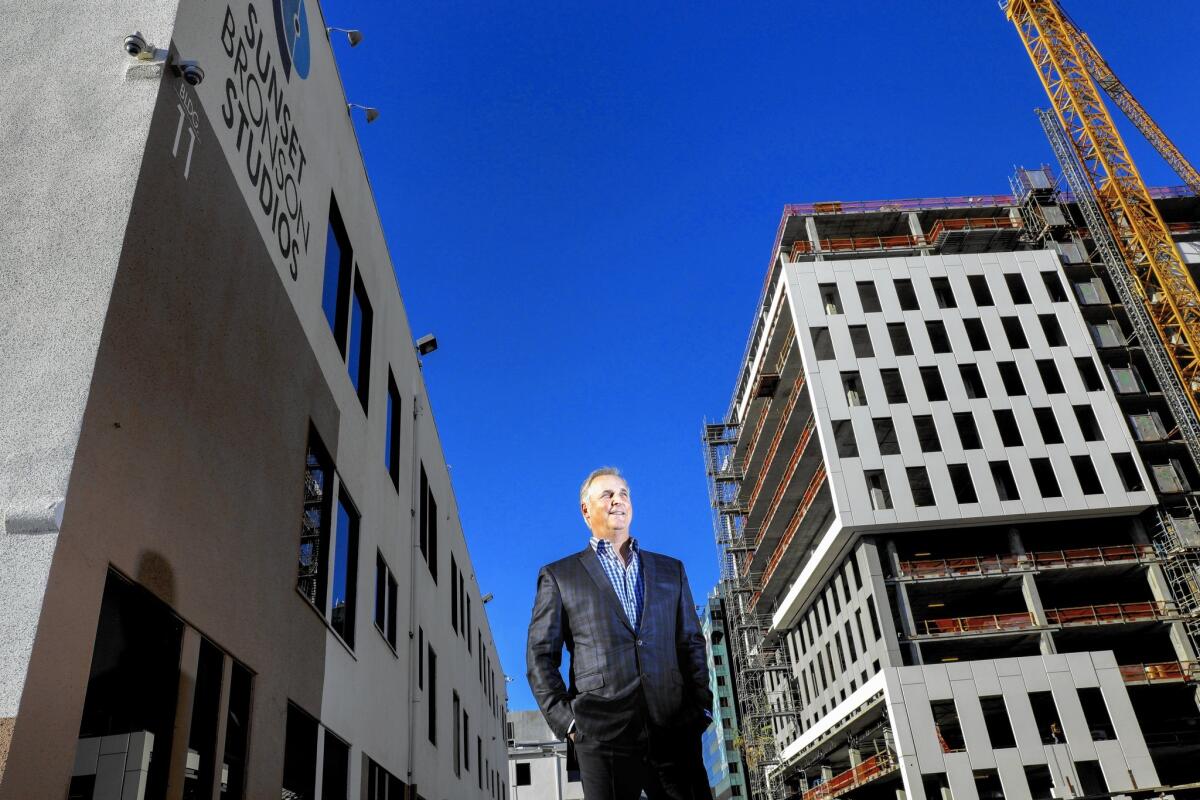How Hollywood studios woo the hottest companies in video-streaming

- Share via
For nearly 100 years, the Sunset Bronson Studios in Hollywood has carved out a place at the technological forefront of show business.
In 1927, brothers Sam and Jack Warner employed the Vitaphone system to produce the first talkie, “The Jazz Singer.” In 1947, KTLA used its lots to become the first commercial television station to broadcast west of the Mississippi.
The studio’s latest update, though, has more to do with connectivity than TV or filmmaking.
------------
FOR THE RECORD
An earlier version of this story spelled general manager of Sunset Bronson and Sunset Gower studios Bill Humphrey’s name wrong.
------------
The makeover includes speedy fiber-optic Internet and a 14-story office tower soon to be decked out with a control room for ultra-high-resolution filming where Hollywood’s hottest new tenant — Netflix — will put the finishing touches on its original programming.
See more of our top stories on Facebook >>
Speed is paramount in the streaming business, and the sooner that Netflix can wrap up its productions, the sooner its 75 million subscribers can begin binge-watching.
“In the technology business, it’s adapt or die. The same is true on studio lots today,” said Victor Coleman, chief executive of Hudson Pacific Properties, which owns the Sunset Bronson Studios. “If you don’t offer state-of-the-art technology and facilities, you’re not going to attract next-generation content creators like Netflix or Amazon.”
Los Gatos, Calif.-based Netflix’s choice of the former Warner Bros. studio as the home of its L.A. headquarters may be the biggest symbol of digital media muscling into the entertainment capital — but it also highlights how the region’s smaller, independently owned studio lots are bending to a burgeoning segment of the industry looking to make faster, and sometimes cheaper, productions.
Across the street on Sunset Boulevard is Siren Studios, which entered a two-year lease to house BuzzFeed Motion Pictures, the video arm of the viral hit makers.
Comedy website Funny or Die is headquartered in a West Hollywood studio lot whose origins date back to Mary Pickford, Douglas Fairbanks and the silent film era.
And the Culver Studios, which was opened in 1918 and where “Citizen Kane,” “Gone With the Wind” and “E.T. the Extra-Terrestrial” were filmed, now counts Amazon and Netflix among its customers.
Even Facebook was said to be calling around for studio space before settling on its new 35,000-square-foot digs in Playa Vista. Meanwhile, DEFY Media is searching for at least 20,000 square feet of new studio space in the L.A. area to accommodate its popular online channels such as Smosh.
The upswing in production comes as Americans are expected to double their daily digital video consumption compared with four years ago to an hour and eight minutes, according to eMarketer.
It’s also mirroring a revival of local TV production thanks to tax incentives introduced in California two years ago. Those tax breaks were aimed at reversing years of decline in film and TV production that was lured away to cheaper locales.
Already, streaming video productions are surging this year. Amazon, Hulu and Netflix were working on 16 scripted shows in February alone, according to FilmL.A. Inc., the nonprofit group that handles film permits for the city and county.
That’s up from just four scripted shows all of last TV season, which starts in the fall and ends in the spring.
Web-based TV, like the shorts you see from YouTube or BuzzFeed, have also seen a significant rise. FilmL.A. Inc. counted 1,449 shooting permits for the category in 2015, compared with 641 in 2011.
The boost in digital production has heightened competition for studio space, which is mostly limited to about a dozen major independently owned properties, though big-name studios like Paramount still make their facilities available for lease.
Hudson Pacific says occupancy rates for its office and soundstage space are near an all-time high at about 80%.
The company, which also owns the nearby Sunset Gower Studios (the former Columbia Pictures lot), is turning away four to six inquiries a week for its soundstages.
“There’s not enough stages in town,” said Bill Humphrey, general manager of Sunset Bronson and Sunset Gower studios. “You’ve got to serve the traditional networks, then the cable networks and now Hulu, YouTube, Amazon and Netflix on top.”
The company has grown its staff by about one-fifth to 50 to accommodate the increased workload the last three years. It spent more than $240 million on capital improvements on the two studio lots since 2010, including the Netflix tower.
Once Netflix starts its 10-year lease, it will have access to soundstages at both Sunset Bronson and Sunset Gower, which are currently cranking out popular TV shows such as ABC’s “Scandal” and HBO’s “Togetherness.”
------------
FOR THE RECORD
An earlier version of this story incorrectly identified the company that creates “Marco Polo.” It is a Netflix show.
------------
Writers for Amazon’s orignal programming also take up office space at Sunset Gower, a 15.6-acre property that’s home to ad agencies, Technicolor Inc.’s digital production facilities and the United Recording Studios, which has played host to the Rat Pack, Michael Jackson and the “We Are the World” video.
That mix of digital media is being replicated throughout Hollywood, no more dramatically than across the street from the Sunset Gower Studios at Columbia Square.
The $420-million office, residential and retail complex will serve as Viacom Inc.’s new West Coast headquarters. The property owners hope that Viacom, which owns MTV, Comedy Central and BET, will attract more entertainment workers to the area.
Whether that includes big tech companies looking to produce original content remains to be seen. Facebook had inquired about leasing a studio in Hollywood, according to real estate sources (Facebook declined to comment).
One major addition, BuzzFeed Motion Pictures, has been in the neighborhood for two years, most recently at Siren Studios.
The boxy building on Sunset Boulevard struggled to attract its bread-and-butter commercial shoots during the worst of the filming exodus. For the productions that remained in L.A., Siren was often overlooked.
“We weren’t getting the first call,” said Dean Gavoni, the studio’s chief executive. “We’re not Paramount or Warner.”
That resulted in some soul searching and a new strategy. Gavoni decided that Siren needed to be more forward-thinking. He was amazed at how his young daughter and her friends consumed almost all their video on their smartphones and tablets.
So when BuzzFeed approached Siren about a lease, Gavoni was wary but willing to take a chance.
“It doesn’t take a genius to figure out this is the next wave,” he said.
If BuzzFeed and its fast and cheap style of production is indeed the future of digital entertainment, then other independent studios may need to adjust.
Unlike some of its competitors, Siren isn’t a union facility, which makes it more attractive to Web-only producers on smaller budgets.
Siren also doesn’t require that BuzzFeed use any of its services such as renting production equipment. By comparison, about one-third of Hudson Pacific’s revenue is from ancillary services like lighting, telecommunications and catering.
And while Siren has embraced BuzzFeed’s young culture, others have raised eyebrows at millennial-minded companies with their workplace happy hours, ping-pong matches and inability to keep their cool when a big star is seen working next door.
“I think they got sick of us,” Maria Gonima, head of communications at digital network Fullscreen, said about the company’s time at the century-old Culver Studios. “We’d see stars like Halle Berry and all of us would get all fangirl and fanboy.”
That doesn’t necessarily mean that the old studios will fall out of favor, said Bruce Richmond, executive vice president of production at HBO, which first launched its streaming service in 2010 and has traditionally worked with union labor.
“For a big movie with 1,000 people, it helps to have a catering service,” he said. “But not for a BuzzFeed crew of four. It’s not a zero-sum game. There’s always room for both types of studios.”
For Netflix, the chance to fit as many as 1,000 employees in an office next door to soundstages proved irresistible. Building an equivalent property from scratch was a non-starter; it would have taken too long even if Netflix could find the available real estate.
“The thought of co-locating offices with production operations was really compelling,” said Amy Dee, Netflix’s director of global real estate, workplace and procurement, who moved to L.A. from Los Gatos in October to oversee the tower project.
The move brings Netflix closer to the actors, directors and writers who produce their shows — an important edge for a company that’s seeing its dominance challenged by Amazon, Hulu and HBO. Moreover, it reinforces the company’s culture, which has one foot in Silicon Valley and the other in show business.
“We wanted to be where Hollywood came to life,” Dee said. “Even though we’re a cutting-edge tech company, we take very seriously the history of the entertainment industry and its roots in Hollywood.”
Twitter: @dhpierson
ALSO
Two more deaths may be linked to contaminated medical scopes
Personal Finance Q&A: Bad boyfriend plagues grandparents’ finances
How Snapchat’s costly acquisition of bitmoji-maker Bitstrips could pay off
More to Read
Inside the business of entertainment
The Wide Shot brings you news, analysis and insights on everything from streaming wars to production — and what it all means for the future.
You may occasionally receive promotional content from the Los Angeles Times.











